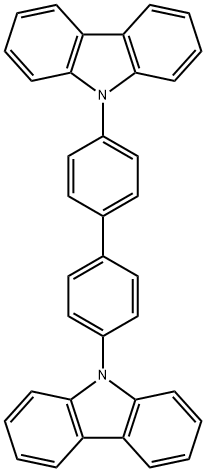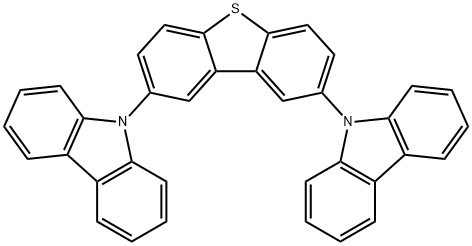1,3-Bis(N-carbazolyl)benzene
Synonym(s):N,N′-Dicarbazolyl-3,5-benzene;1,3-Di(9H-carbazol-9-yl)benzene;9,9′-(1,3-Phenylene)bis-9H-carbazole;mCP
- CAS NO.:550378-78-4
- Empirical Formula: C30H20N2
- Molecular Weight: 408.49
- MDL number: MFCD09836836
- SAFETY DATA SHEET (SDS)
- Update Date: 2025-08-08 17:45:00

What is 1,3-Bis(N-carbazolyl)benzene?
Description
1,3-Bis(N-carbazolyl)benzene, known as mCP, with a high triplet energy (ET ?= 2.91 eV) and a very deep highest occupied?molecular orbital (HOMO) level, is often used as host materials for efficient blue phosphorescent light-emitting diodes. Kawamura et al. demonstrated that the photoluminescence internal quantum yield of the blue emitter of FIrpic could approach nearly 100% when doped into the wide energy gap host of mCP .
The Uses of 1,3-Bis(N-carbazolyl)benzene
9,9'-(1,3-Phenylene)bis-9H-carbazole uses as a phosphorescent host material
The Uses of 1,3-Bis(N-carbazolyl)benzene
Material for use as a phosphorescent host material
References
[1] JUAN MENTADO-MORALES. A Promising Thermodynamic Study of Hole Transport Materials to Develop Solar Cells: 1,3-Bis(N-carbazolyl)benzene and 1,4-Bis(diphenylamino)benzene.[J]. Molecules, 2022. DOI:10.3390/molecules27020381.
[2] DAE-KYU KIM; Jong H C; Yoo Lim Kim. Organic Light-Emitting Transistors Based on Pentacene and 4,5-Di(9H-carbazol-9-yl)phthalonitrile Doped onto 1,3-Bis(N-carbazolyl)benzene[J]. The Journal of Physical Chemistry C, 2019. DOI:10.1021/acs.jpcc.9b00150.
Properties of 1,3-Bis(N-carbazolyl)benzene
| Melting point: | 176-178°C |
| Boiling point: | 644.2±51.0 °C(Predicted) |
| Density | 1.21 |
| storage temp. | Sealed in dry,Room Temperature |
| form | powder to crystal |
| color | White to Almost white |
| InChI | InChI=1S/C30H20N2/c1-5-16-27-23(12-1)24-13-2-6-17-28(24)31(27)21-10-9-11-22(20-21)32-29-18-7-3-14-25(29)26-15-4-8-19-30(26)32/h1-20H |
| Absorption | λmax 292, 338 nm (in THF) |
Safety information for 1,3-Bis(N-carbazolyl)benzene
| Signal word | Danger |
| Pictogram(s) |
 Corrosion Corrosives GHS05  Exclamation Mark Irritant GHS07 |
| GHS Hazard Statements |
H315:Skin corrosion/irritation H318:Serious eye damage/eye irritation H335:Specific target organ toxicity, single exposure;Respiratory tract irritation |
| Precautionary Statement Codes |
P280:Wear protective gloves/protective clothing/eye protection/face protection. P302+P352:IF ON SKIN: wash with plenty of soap and water. |
Computed Descriptors for 1,3-Bis(N-carbazolyl)benzene
| InChIKey | MZYDBGLUVPLRKR-UHFFFAOYSA-N |
| SMILES | C1(N2C3=C(C=CC=C3)C3=C2C=CC=C3)=CC=CC(N2C3=C(C=CC=C3)C3=C2C=CC=C3)=C1 |
New Products
4,4-Difluoropiperidine hydrochloride tert-butyl 9-methoxy-3-azaspiro[5.5]undecane-3-carboxylate Indole Methyl Resin N-Isopropylurea N,N-Dicyclohexylcarbodiimide(DCC) MELDRUMS ACID 5-METHYLISOXAZOLE-4-CARBOXYLIC ACID Magnessium Bis glycinate Zinc ascorbate 1-bromo-2-butyne 2-acetamidophenol 9(10H)-anthracenone Erythrosin B, 4-Piperidinopiperidine 2-((4-morpholinophenylamino) (methylthio) methylene) malononitrile 2,4-dihydroxybenzaldehyde 3-(4-morpholinophenylamino)-5-amino-1H-pyrazole-4-carbonitrile Methyl 2-methylquinoline-6-carboxylate 2,6-dichloro-4-nitropyridine 4-Bromo-2-chlorobenzonitrile 2-(benzylamino)acetic acid hydrochloride 4-(tert-Butoxycarbonylamino)but- 2-ynoic acid 3,4-dihydro-2H-benzo[b][1,4]dioxepine 1-Phenyl-1-cycloprppanecarboxylicacidRelated products of tetrahydrofuran

![Bis[2-(diphenylphosphino)phenyl] ether oxide](https://img.chemicalbook.in/CAS/20150408/GIF/808142-23-6.gif)






You may like
-
 550378-78-4 1,3-Di-9-carbazolylbenzene 98%View Details
550378-78-4 1,3-Di-9-carbazolylbenzene 98%View Details
550378-78-4 -
 1,3-Di-9-carbazolylbenzene (purified by sublimation) CAS 550378-78-4View Details
1,3-Di-9-carbazolylbenzene (purified by sublimation) CAS 550378-78-4View Details
550378-78-4 -
 1,3-Bis(N-carbazolyl)benzene CAS 550378-78-4View Details
1,3-Bis(N-carbazolyl)benzene CAS 550378-78-4View Details
550378-78-4 -
 3-(4-amino-1-oxoisoindolin-2-yl)-1-methylpiperidine-2,6-dione 98%View Details
3-(4-amino-1-oxoisoindolin-2-yl)-1-methylpiperidine-2,6-dione 98%View Details -
 20677-73-0 (2,2-diethoxyethyl)methylamine 98%View Details
20677-73-0 (2,2-diethoxyethyl)methylamine 98%View Details
20677-73-0 -
 3-(4-(hydroxyamino)-1-oxoisoindolin-2-yl)piperidine-2,6-dione 98%View Details
3-(4-(hydroxyamino)-1-oxoisoindolin-2-yl)piperidine-2,6-dione 98%View Details -
 57381-49-4 2-bromo-4-chlorobenzonitrile 98%View Details
57381-49-4 2-bromo-4-chlorobenzonitrile 98%View Details
57381-49-4 -
 4,6-dichloropyrimidine-5-carbaldehyde 98%View Details
4,6-dichloropyrimidine-5-carbaldehyde 98%View Details
5305-40-8
